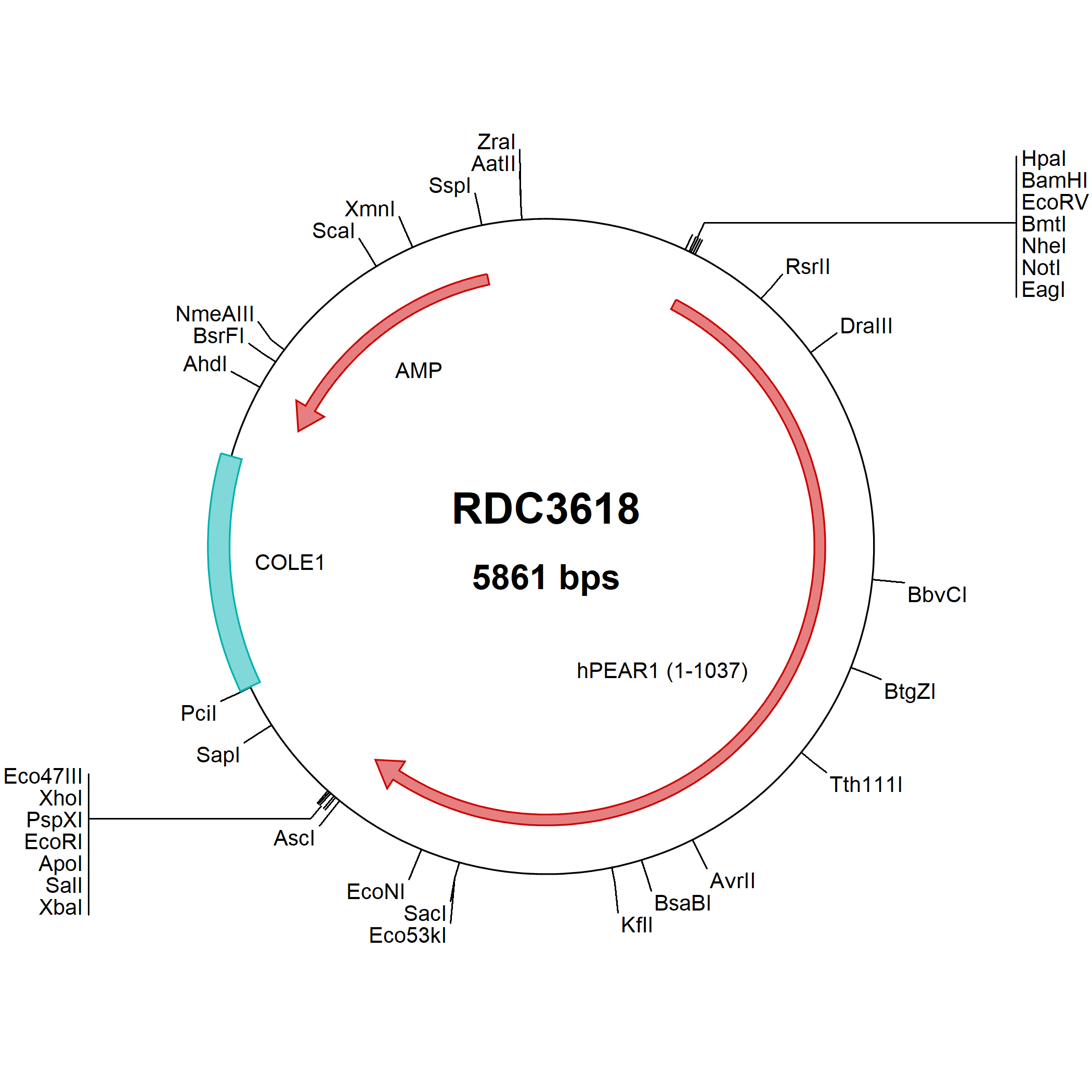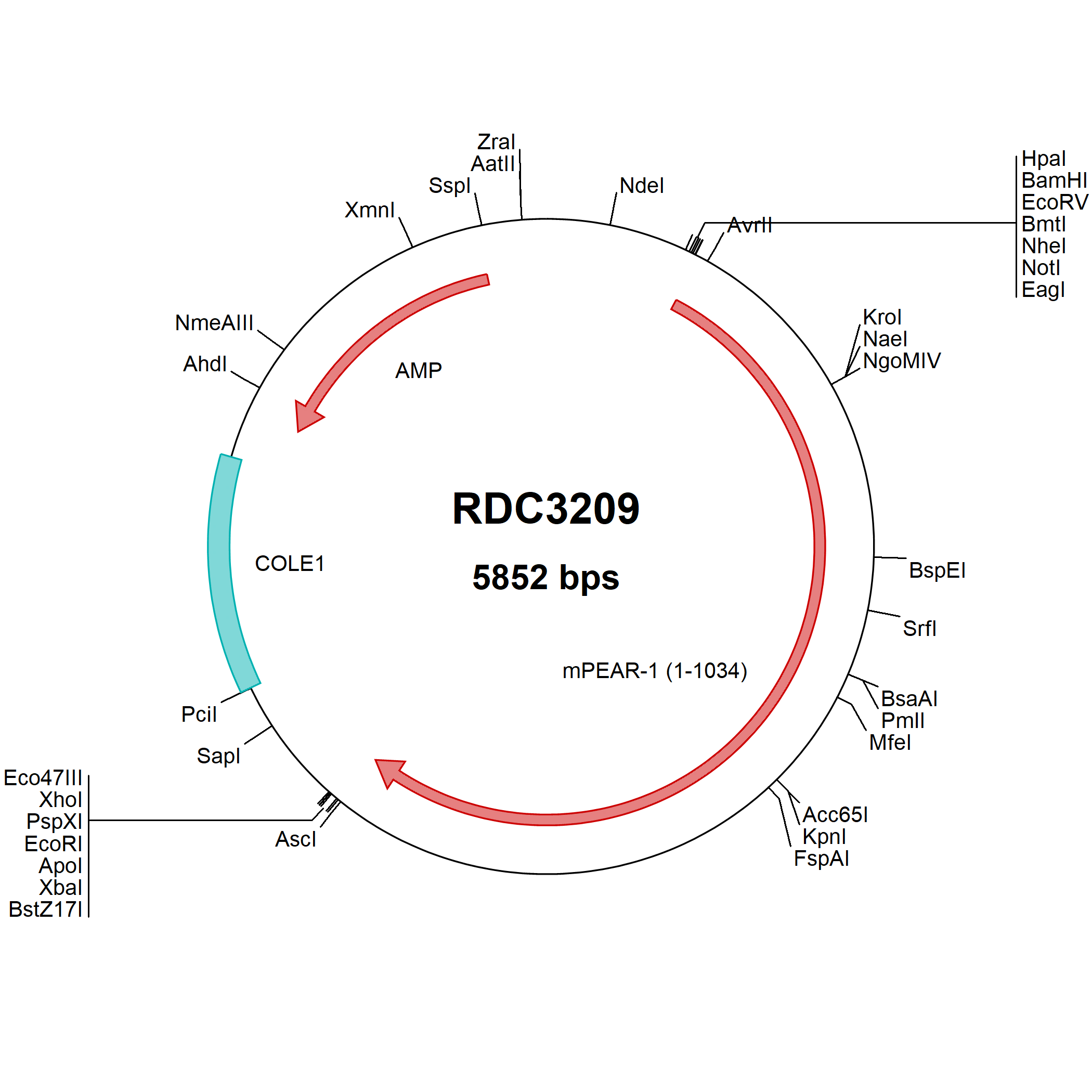PEAR1 Products
Platelet endothelial aggregation receptor 1 (PEAR1) is a 150 kDa type I transmembrane protein and member of the MEGF family of proteins. Human PEAR1 is synthesized as a 1037 amino acid (aa) precursor that contains a 20 aa signal sequence, a 735 aa extracellular domain (ECD), a 21 aa transmembrane region, and a 261 aa cytoplasmic region. The ECD consists of 15 EGF-like repeats that vary in length from 39 to 42 aa and contain a consensus sequence of CX1-2GX2GX2-4CX3CX1-3CX1-2GX1-2CX4GX1CX1CX2GX2GX2C. The consensus repeat contains six conserved glycine residues and eight conserved cysteine residues, suggesting four disulfide-bonded cysteine pairs in each EGF repeat. Within the ECD, there are also five potential sites for N-linked glycosylation. The cytoplasmic region contains five potential Src homology 3-binding, proline-rich domains. Mature human PEAR1 is 84% aa identical to mature mouse PEAR1. PEAR1 is most highly expressed in platelets and endothelial cells. Functionally, PEAR1 is a receptor for a yet undetermined ligand that signals upon the formation of platelet-platelet contacts induced both by platelet aggregations and by platelet centrifugation. The signaling enhances and stabilizes platelet thrombi. Upon aggregation, the surface-expressed protein is tyrosine-phosphorylated. This phosphorylation event is inhibited by the alphaIIbbeta3 antagonist eptifibatide, thus demonstrating that PEAR1 tyrosine phosphorylation is dependent on surface contacts between activated platelets. PEAR1 can be phosphorylated in an alphaIIbbeta3 integrin-dependent manner on tyrosine (Tyr925) and serine residues (Ser593 and Ser1029) and, potentially, at Tyr804, Tyr943, and Tyr979. Inherited PEAR1 variations that alter expression or function of the platelet signaling molecule could modify agonist-induced aggregation in native platelets. In addition, a genetic variant in PEAR1 could be an important determinant of residual platelet function during aspirin treatment, because the COX1/thromboxane A2 pathway will be strongly inhibited by aspirin, and maximal aggregation will then be dependent on other secondary signaling pathways.
43 results for "PEAR1" in Products
43 results for "PEAR1" in Products
PEAR1 Products
Platelet endothelial aggregation receptor 1 (PEAR1) is a 150 kDa type I transmembrane protein and member of the MEGF family of proteins. Human PEAR1 is synthesized as a 1037 amino acid (aa) precursor that contains a 20 aa signal sequence, a 735 aa extracellular domain (ECD), a 21 aa transmembrane region, and a 261 aa cytoplasmic region. The ECD consists of 15 EGF-like repeats that vary in length from 39 to 42 aa and contain a consensus sequence of CX1-2GX2GX2-4CX3CX1-3CX1-2GX1-2CX4GX1CX1CX2GX2GX2C. The consensus repeat contains six conserved glycine residues and eight conserved cysteine residues, suggesting four disulfide-bonded cysteine pairs in each EGF repeat. Within the ECD, there are also five potential sites for N-linked glycosylation. The cytoplasmic region contains five potential Src homology 3-binding, proline-rich domains. Mature human PEAR1 is 84% aa identical to mature mouse PEAR1. PEAR1 is most highly expressed in platelets and endothelial cells. Functionally, PEAR1 is a receptor for a yet undetermined ligand that signals upon the formation of platelet-platelet contacts induced both by platelet aggregations and by platelet centrifugation. The signaling enhances and stabilizes platelet thrombi. Upon aggregation, the surface-expressed protein is tyrosine-phosphorylated. This phosphorylation event is inhibited by the alphaIIbbeta3 antagonist eptifibatide, thus demonstrating that PEAR1 tyrosine phosphorylation is dependent on surface contacts between activated platelets. PEAR1 can be phosphorylated in an alphaIIbbeta3 integrin-dependent manner on tyrosine (Tyr925) and serine residues (Ser593 and Ser1029) and, potentially, at Tyr804, Tyr943, and Tyr979. Inherited PEAR1 variations that alter expression or function of the platelet signaling molecule could modify agonist-induced aggregation in native platelets. In addition, a genetic variant in PEAR1 could be an important determinant of residual platelet function during aspirin treatment, because the COX1/thromboxane A2 pathway will be strongly inhibited by aspirin, and maximal aggregation will then be dependent on other secondary signaling pathways.
| Reactivity: | Mouse |
| Details: | Sheep IgG Polyclonal |
| Applications: | WB, Flow, CyTOF-ready |
| Reactivity: | Human |
| Details: | Mouse IgG2a Monoclonal Clone #492621 |
| Applications: | WB, Flow, CyTOF-ready |
| Reactivity: | Human |
| Details: | Goat IgG Polyclonal |
| Applications: | WB, Flow, CyTOF-ready |
| Source: | CHO |
| Accession #: | NP_001073940 |
| Applications: | BA |
| Reactivity: | Human |
| Details: | Mouse IgG2a Monoclonal Clone #492621 |
| Applications: | Flow |
| Reactivity: | Human |
| Details: | Goat IgG Polyclonal |
| Applications: | WB |
| Reactivity: | Human |
| Details: | Mouse IgG2a Monoclonal Clone #492621 |
| Applications: | Flow |
| Reactivity: | Human |
| Details: | Mouse IgG2a Monoclonal Clone #492621 |
| Applications: | Flow |
| Reactivity: | Human |
| Details: | Mouse IgG2a Monoclonal Clone #492621 |
| Applications: | Flow |
| Reactivity: | Human |
| Details: | Mouse IgG2a Monoclonal Clone #492621 |
| Applications: | Flow |
| Reactivity: | Human |
| Details: | Mouse IgG2a Monoclonal Clone #492621 |
| Applications: | Flow |
| Reactivity: | Human |
| Details: | Mouse IgG2a Monoclonal Clone #492621 |
| Applications: | Flow |
| Reactivity: | Human |
| Details: | Rabbit IgG Polyclonal |
| Applications: | IHC, ICC/IF |
| Applications: | AC |
| Reactivity: | Human |
| Details: | Mouse IgG2A Monoclonal Clone #492621 |
| Applications: | WB, Flow, CyTOF-ready |
| Reactivity: | Human |
| Details: | Mouse IgG2A Monoclonal Clone #492621 |
| Applications: | WB, Flow, CyTOF-ready |
| Reactivity: | Human |
| Details: | Mouse IgG2A Monoclonal Clone #492621 |
| Applications: | WB, Flow, CyTOF-ready |
| Reactivity: | Human |
| Details: | Mouse IgG2A Monoclonal Clone #492621 |
| Applications: | WB, Flow, CyTOF-ready |
| Reactivity: | Human |
| Details: | Mouse IgG2A Monoclonal Clone #492621 |
| Applications: | WB, Flow, CyTOF-ready |
| Reactivity: | Human |
| Details: | Mouse IgG2A Monoclonal Clone #492621 |
| Applications: | Flow |
| Reactivity: | Human |
| Details: | Mouse IgG2A Monoclonal Clone #492621 |
| Applications: | WB, Flow, CyTOF-ready |
| Reactivity: | Human |
| Details: | Mouse IgG2A Monoclonal Clone #492621 |
| Applications: | WB, Flow, CyTOF-ready |
| Reactivity: | Human |
| Details: | Mouse IgG2A Monoclonal Clone #492621 |
| Applications: | WB, Flow, CyTOF-ready |







![Immunocytochemistry/ Immunofluorescence: PEAR1 Antibody [NBP1-90449] Immunocytochemistry/ Immunofluorescence: PEAR1 Antibody [NBP1-90449]](https://resources.bio-techne.com/images/products/PEAR1-Antibody-Immunocytochemistry-Immunofluorescence-NBP1-90449-img0005.jpg)


